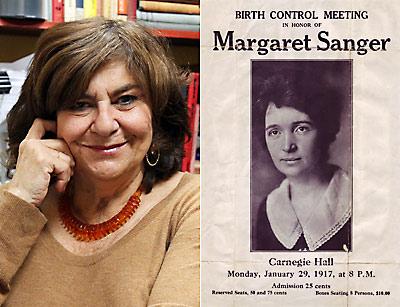Margaret Sanger, The Mother of Birth Control

It may be almost impossible today for someone under 40 to believe that birth control was not legal in the United States until 1960, and then only between a husband and wife. The so-called “Comstock” chastity laws kept the sale of contraceptives illegal in eight states until 1966, the same year that Margaret Sanger, the founder of the modern birth control movement, died in Phoenix just shy of her 87th birthday.
“She got to see the spread of the movement she started,” said Esther Katz, the editor and director of the Margaret Sanger Papers Project at New York University, and a Springs resident. Dr. Katz is at work on the final volume of the four-volume “The Selected Papers of Margaret Sanger: Round the World for Birth Control, 1920-1966.” The series is taken from over 120,000 of Ms. Sanger’s papers and letters that continue to turn up all over the world, documents found in a 10-year international search of over 1,500 archives and private collections.
Because of Ms. Sanger’s world travels promoting the birth control movement, “papers were scattered all over the place,” Dr. Katz said. She founded the project in 1985 as a historical editing project.
The Margaret Sanger Papers Project put out a microfilm edition based on documents in the Smith College collections, which include over 50,000 of Ms. Sanger’s documents. “A lot of the stuff was private,” said Dr. Katz, who “hadn’t expected all the affairs,” the documentation of which includes “cryptic little postcards” from H.G. Wells.
Margaret Sanger traveled around the world as a vocal supporter of birth control, “but her muted agenda was to give women the same freedom as men,” Dr. Katz said.
Many of the letters that came to Ms. Sanger, and which are in the collection, are pleas for help obtaining birth control. “It’s heart-rending,” Dr. Katz said. “One says, ‘I have six children, my husband’s out of work, I’m already sick, please help.’ There are hundreds of letters like that.”
Margaret Sanger first became a champion for contraception when she worked as an obstetric nurse on the Lower East Side of Manhattan. It was there, in the early 1900s, where she saw up close and personal the high death rates for infants and mothers in that poverty-stricken area of New York, and decided to do something about it. She coined the term “birth control,” and saw it as a way of prolonging life and health in women. Her own mother had 18 pregnancies in two decades, and died early of cervical cancer.
The first day her clinic opened in Brooklyn in 1916, over 100 women showed up. Only a week later, Ms. Sanger was arrested, along with two nurses. She reopened the clinic two more times, only to be arrested and have her clinic shut down permanently.
In 1921, Ms. Sanger founded the American Birth Control League, which eventually morphed into Planned Parenthood. Ms. Sanger remained president until she turned 80.
Planned Parenthood has been in the news this week, as the Susan G. Komen for the Cure breast-cancer foundation announced that it has withdrawn its funding for Planned Parenthood for breast cancer screening and other programs, leading to a social media outcry and resignations.
“I know Margaret Sanger would be appalled by any effort to cut funds to any group that was working to keep women healthy, as well as to provide them access to reliable birth control,” Dr. Katz said. “In Sanger’s view, women’s health and access to birth control were one and the same.”
“She looked at what she really believed would help women — not the vote. It was sexual freedom, to decide what they could do with their own bodies.”
